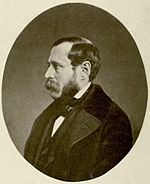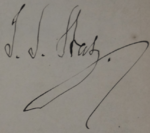Jean Stas facts for kids
Quick facts for kids
Jean Stas
|
|
|---|---|

Jean Stas
|
|
| Born | 21 August 1813 |
| Died | 13 December 1891 (aged 78) |
| Nationality | Belgian |
| Known for | Accurate determination of atomic weights Co-discoverer of the atomic weight of carbon Forensic chemistry |
| Awards | Davy Medal (1885) |
| Scientific career | |
| Fields | Chemistry |
| Influences | Jean-Baptiste Dumas |
| Signature | |
 |
|
Jean Servais Stas (born August 21, 1813 – died December 13, 1891) was a Belgian chemist. He is famous for helping to find the atomic weight of carbon. He also made very accurate measurements of other elements.
Contents
Jean Stas's Life and Discoveries
Jean Stas was born in Leuven, a city in Belgium. He first studied to become a doctor. But he soon changed his mind and decided to study chemistry instead. He worked in Paris, France, with a famous chemist named Jean-Baptiste Dumas.
Discovering Carbon's Atomic Weight
Stas and Dumas worked together on an important project. They wanted to find the exact atomic weight of carbon. Atomic weight is like the "heaviness" of an atom compared to other atoms. They did this by carefully weighing a pure piece of carbon. Then, they burned it in pure oxygen gas. When carbon burns in oxygen, it creates carbon dioxide. They weighed the carbon dioxide produced. By comparing these weights, they could figure out carbon's atomic weight.
Measuring Elements Accurately
Later, Stas became a professor in Brussels, Belgium, in 1840. He became known around the world for making the most accurate measurements of atomic weights ever done. He used oxygen with an atomic mass of 16 as his standard. This means he compared the weight of other atoms to oxygen.
His careful work showed that an idea by an English scientist named William Prout was not quite right. Prout thought that all atomic weights were exact multiples of hydrogen's weight. Stas's precise measurements proved this wasn't true for all elements.
Stas's very accurate measurements were super important. They helped other scientists, like Dmitri Mendeleev, create the periodic system of elements. The periodic table organizes all the elements based on their properties and atomic weights.
Supporting the Law of Conservation of Mass
Stas's experiments also helped prove a very important rule in chemistry: the conservation of mass. This law says that in a chemical reaction, matter is neither created nor destroyed. The total mass of the chemicals you start with will be the same as the total mass of the chemicals you end with. Stas's research showed that any loss or gain in mass during a reaction was incredibly tiny, almost impossible to measure. This showed how truly accurate this law is.
Later Life
Stas stopped working in 1869 because of a problem with his voice. He then worked as a commissioner for the mint, which makes coins. But he left that job in 1872 because he didn't agree with the government's money policies. Jean Stas passed away in Brussels and was buried in Leuven.
Honors and Awards
Jean Stas received many awards for his important work:
- He became a Foreign Member of the Royal Society of London in 1879.
- He was awarded the Davy Medal in 1885. This is a very important award for chemists.
On May 5, 1891, a special event was held to celebrate 50 years of Jean Servais Stas being a member of the Royal Academy of Belgium. Many people spoke about his amazing contributions to science. He received a special medal made by a Belgian artist and an album filled with praise from science groups all over the world.
Images for kids
See also
 In Spanish: Jean Stas para niños
In Spanish: Jean Stas para niños
- Theodore William Richards
- Law of reciprocal proportions
- Mass spectrometry
- Toxicology


